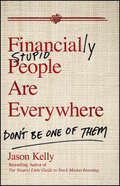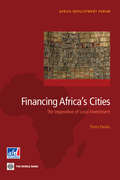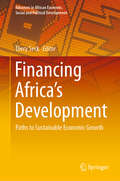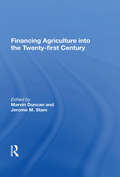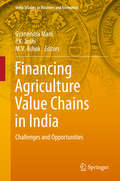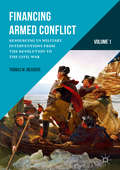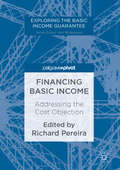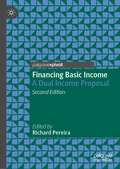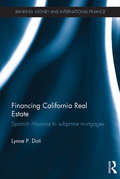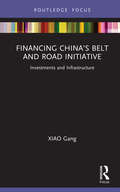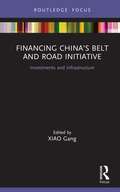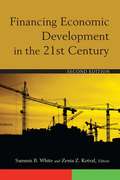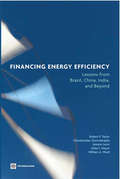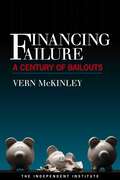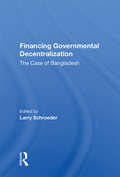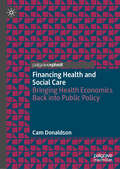- Table View
- List View
Financially Stupid People Are Everywhere
by Jason KellyA hard-hitting look at achieving financial freedom by avoiding excessive borrowing and spendingIf you don't actively resist America's culture of debt, you'll end up precisely where the government, banks, and big business want you to be: indentured servitude. The mistakes people make with their money are basic, and avoidable, and unless you understand what they are, you're probably going to repeat them. What you need is someone who can shed light on the obstacles we face and show you how to avoid getting tripped up by them.Financially Stupid People Are Everywhere shows how society is rigged to take as much of your wealth as possible, and simple ways you can resist. It investigates, explains, and offers advice for all those who have fallen into debt, taken a second mortgage, been trapped by credit cards, or found themselves unable to get ahead.Discusses what you can do to stop the destructive cycle of borrowing and spendingIllustrates the four major tenets of getting money rightHighlights how to avoid the many ways that government, banks, and big business try to trap you with debtTo secure your financial future, you must break the dangerous cycle of borrowing and spending, and learn how to guard your wealth against corporate ploys. Financially Stupid People Are Everywhere leads you down the only proven path to financial freedom.
Financiar las palabras: Una guía acerca del dinero y los impuestos para autores
by Alma Edith Garcia Pavarti K. TylerOrganizar tus finanzas personales significa ganar más dinero y ¿quién no quiere ganar más dinero? Los escritores tienden a ser personas con facilidad para las palabras, ¡lo que significa que la temporada de pago de impuestos puede causarles mucha angustia! ¿Has estado tomando todas las medidas necesarias para asegurarte de que puedas maximizar tu devolución? ¿Estás guardando todos tus recibos en una caja de zapatos? ¿Tienes pesadillas llenas de signos de dólares flotando en el aire y mientras te preocupas por todo el dinero que vas a deber después de que por fin termines de declarar impuestos? ¡ Financiar las palabras está aquí para ayudarte! Prepárate para aprender todo lo que jamás hayas necesitado aprender sobre operar tu propio negocio y declarar impuestos como autor y a dedicar tan sólo unas horas a preparar tus registros. Con Pavarti K. Tyler como tu guía, harás un recorrido por los números, aprenderás cuáles gastos son deducibles y cuáles no, te enterarás de trucos para preparar tu empresa como autor y recibirás recomendaciones innovadoras para aplicar tu talento y agregar un poco más de grosor a tu alcancía. Con este guía, recibirás explicaciones prácticas y fáciles de entender acerca de cómo organizar y como administrar tus finanzas, incluyendo: Cómo ser un emprendedor exitoso La regla de impuestos #1 que tienes que saber Ganar dinero y qué hacer con él Los pros y contras de establecer una sociedad Los pagos a diseñadores, editores y otros contratistas Preguntas frecuentes Maximizar tus deducciones Determinar cuáles son tus bienes o activos Ganar dinero por gastar dinero Contratar a un profesional de impuestos o presentar tu declaración tú mismo ¡También ofrecemos nueve regalos exclusivos para los lectores de este libro! Nuestra garantía: ¿Estás cansado de examinar meticulosamente las guías de marketing que se centran más en la experienc
Financing Africa's Cities
by Thierry PaulaisThis volume addresses the issues of financing urban growth of the African continent -- which has the highest urban growth rate on the planet -- in the next decades. Considerable investment will be needed to sustain this level of growth and to clear up accumulated backlogs. At the same time, decentralisation has resulted in increased responsibilities for local government; but in most cases, institutional reforms were carried out without the transfer of a sufficient level of resources, and local capacities in governance and project management are weak. Which mechanisms will finance these extensive needs, and how will African local governments meet these needs? Specifics on how to finance African cities have not been studied. The actual scale of this market has not been fully grasped. A systemic approach to this market is difficult because of its diversity (country size; institutional context; characteristics of urban network; availability of capital market, currency, etc. ) and a lack of data. Donors' assistance methods in the sector are disparate, marked by disputes between different schools of thought; special-purpose vehicles created by donors operate according to a variety of methods and with wide-ranging and sparsely disseminated results. What is the best way to transform these systems, often antiquated in many respects, into modern financing systems that facilitate access to domestic markets, mobilize local savings and reinforce local government autonomy? There is no single answer to this question in regard to such a variety of institutional and economic contexts. The main objective of the study is to clarify the debates and to enlighten the choices of African decision-makers at local and national level.
Financing Africa’s Development: Paths to Sustainable Economic Growth (Advances in African Economic, Social and Political Development)
by Diery SeckThis book examines the impact of financing on Africa’s economic development. By exploring various financial instruments including the role of alternative sources of funding like migrant remittances and illicit flows, it analyses the role of financing for Africa’s macroeconomic development and other development indicators such as infrastructure, transport, global trade, industrialisation, social services, external indebtedness and governance. By presenting and examining case studies on various African countries and regions, the respective contributions investigate the capacity of institutions to facilitate and structure the economy’s funding activities, and to strengthen the ties between finance and development. Furthermore, they discuss various regional aspects, such as the integration of infrastructure, harmonization of fiscal policy, integration of financial markets, and the facilitation of intra-regional trade and movement of capital. Given its scope, the book will appeal to scholars of economics and development studies with an interest in the economic development of Africa.
Financing Agriculture Into The Twenty-first Century
by Marvin DuncanThis volume is concerned with the paradigm shifts occurring in U.S. agriculture and its related financial services sector. The U.S. agricultural sector is undergoing rapid change with large segments commonly described as industrialized. Often observers focus on the technological and structural changes that the sector is undergoing and ignore other
Financing Agriculture Value Chains in India
by P. K. Joshi Gyanendra Mani M. V. AshokThis book examines the successful private, public and civil society models of agriculture value chains in India and addresses relevant challenges and opportunities to improve their efficiency and inclusiveness. It promotes the value-chain approach as a tool to improve access to finance for small holder farmers and discusses the possible structure of and regulatory framework for the 'National Common Agricultural Market'-- a term that featured in the Indian Finance Minister's 2014-15 budget speech, and which is aimed towards standardizing and improving transparency in agricultural trade practices across states under a single licensing system. The book deliberates on the potential of developing innovative financial instruments into the value chain framework by supporting tripartite agreements between producers, lead firms and financial institutions. Its fourteen chapters are divided into three parts--Agriculture Value Chain Financing: Theoretical Framework, Agriculture Value Chain Financing in Cases of Select Commodities; and Institutional Framework for Agriculture Value Chain Financing. Since the concept of value chain financing is being considered as a future policy agenda, the book is of great interest to corporations dealing with agricultural inputs and outputs; commercial, regional, rural and cooperative banks; policy makers; academicians and NGOs.
Financing American Higher Education in the Era of Globalization
by Joni E. Finney James B. Hunt Jr. William Zumeta Patrick M. Callan David W. BrenemanThis ambitious book grows out of the realization that a convergence of economic, demographic, and political forces in the early twenty-first century requires a fundamental reexamination of the financing of American higher education. The authors identify and address basic issues and trends that cut across the sectors of higher education, focusing on such questions as how much higher education the country needs for individual opportunity and for economic viability in the future; how responsibility for paying for it is currently allocated; and how financing higher education should be addressed in the future.
Financing American Higher Education in the Era of Globalization
by Joni E. Finney William Zumeta Patrick M. Callan David W. BrenemanThis ambitious book grows out of the realization that a convergence of economic, demographic, and political forces in the early twenty-first century requires a fundamental reexamination of the financing of American higher education. The authors identify and address basic issues and trends that cut across the sectors of higher education, focusing on such questions as how much higher education the country needs for individual opportunity and for economic viability in the future; how responsibility for paying for it is currently allocated; and how financing higher education should be addressed in the future.
Financing Anghami's Growth
by Ramana Nanda Eren KuzucuIn December 2012, less than two years into the founding of their music-streaming platform Anghami, cofounders Elie Habib and Eddy Maroun found themselves evaluating an unorthodox term sheet. Habib and Maroun needed to make a decision vis- -vis the proposal put forth by the MBC Group, the region's largest media network. The offer was a media-for-equity deal, which would provide Anghami with advertising towards the media giant's millions of viewers and boost its chances of competing with the likes of iTunes and Spotify in the Middle Eastern market. However, the deal would also cost the cofounders a significant share of their company, and might place them in the middle of a rivalry between MBC and Rotana, the region's largest music label. The case takes the reader through the co-founders' journey, from the founding of the company to the successes and challenges they have faced navigating product launch, scale-up, and partnerships.
Financing Armed Conflict, Volume 1
by Thomas M. MeagherThis first part of a two-volume series examines in detail the financing of America's major wars from the American Revolution to the Civil War. It interweaves analyses of political policy, military strategy and operations, and war finance and economic mobilization with examinations of the events of America's major armed conflicts, offering useful case studies for students of military history and spending policy, policymakers, military comptrollers, and officers in training.
Financing Armed Conflict, Volume 2
by Thomas M. MeagherThis second part of a two-volume series examines in detail the financing of America's major wars from the Spanish-American War to the Vietnam War. It interweaves analyses of political policy, military strategy and operations, and war finance and economic mobilization with examinations of the events of America's major armed conflicts, offering useful case studies for students of military history and spending policy, policymakers, military comptrollers, and officers in training.
Financing Basic Income
by Richard PereiraThis Palgrave Pivot argues that basic income at a decent level is, in fact, affordable. The contributors approach the topic from the perspectives of three different countries--Canada, Switzerland, and Australia--to overcome objections that a universal program to keep all citizens above the poverty line would be too expensive to implement. They assess the complex array of revenue sources that can make universal basic income feasible, from the underestimated value of public program redundancies to new and so far unaccounted publicly owned assets.
Financing Basic Income: A Dual Income Proposal (Exploring the Basic Income Guarantee)
by Richard PereiraThis Palgrave Pivot second edition argues that basic income is, in fact, affordable. The contributors approach the topic from the perspectives of three different countries—Canada, Switzerland, and Australia—to overcome objections that a universal program to keep all citizens above the poverty line would be too expensive to implement. They assess the complex array of revenue sources that can make universal basic income feasible, from the underestimated value of public program redundancies to new and so far, unaccounted publicly owned assets.This new edition adds an analysis for financing basic income in the United States, as well as considering the basic income potential in a country of far more modest economic resources, Portugal. The COVID-19 pandemic is discussed in a new Prologue, demonstrating the need for universal economic security as a precautionary measure for unforeseen crises. New research and compelling analyses are included throughout, to provide support for a dual basic income proposal.
Financing California Real Estate: Spanish Missions to subprime mortgages (Banking, Money and International Finance)
by Lynne P. DotiCalifornia was at the epicentre of the collapse of the real estate market in 2008, which had a devastating effect on the world economy. Taking this diverse and powerful state as a case study, this book presents a financial history of the property business, from the time Spanish Missions were established to the Great Recession. Financing California Real Estate provides the history of expansions and contractions in the real estate market, and describes factors in the state and nation which may have triggered changes in the direction of growth in real estate lending. It explores how financial institutions which provided funding for building and buying homes changed over time, from the establishment of Spanish Missions in 1769, to the Gold Rush, to rail transportation, all the way through to the real estate bubble that peaked in 2005. Using detailed information on financial institutions to explain the changing nature of the real estate market, this book ultimately suggests an alternative theory for what led to the Great Recession. This book will be of interest to researchers working in the area of real estate cycles in the economy, historians interested in the economy of California, and financial historians.
Financing China’s Belt and Road Initiative: Investments and Infrastructure (China Finance 40 Forum Books)
by XIAO GangCentering on the investment and financing infrastructure of China’s Belt and Road Initiative (BRI), this book puts forth the basic principles and general objectives of constructing a new investment and financing system of this magnitude. Beginning with a succinct analysis of the practical issues faced while developing the BRI’s investment and financing system, the author puts forward several approaches to optimizing and reestablishing the system for the further advancement of investment and financing among and beyond the Belt and Road countries. Topics include credit rules, management and control systems, investment protection, dispute settlement and risk assessment while establishing a new mechanism that helps resolve debt defaults, checks for potential corruption and bribery, fosters new growth, and enhances information transparency. The book will be a practical reference for researchers interested in the Belt and Road Initiative and world investment and finance, as well as policymakers, financial institutions and enterprises relevant to the BRI.
Financing China’s Belt and Road Initiative: Investments and Infrastructure (China Finance 40 Forum Books)
by Xiao GangCentering on the investment and financing infrastructure of China's Belt and Road Initiative (BRI), this book puts forth the basic principles and general objectives of constructing a new investment and financing system of this magnitude. Beginning with a succinct analysis of the practical issues faced while developing the BRI's investment and financing system, the authors put forward several approaches to optimizing and reestablishing the system for the further advancement of investment and financing among and beyond the Belt and Road countries. Topics include credit rules, management and control systems, investment protection, dispute settlement and risk assessment while establishing a new mechanism that helps resolve debt defaults, checks for potential corruption and bribery, fosters new growth, and enhances information transparency. The book will be a practical reference for researchers interested in the Belt and Road Initiative and world investment and finance, as well as policymakers, financial institutions and enterprises relevant to the BRI.
Financing Clean Energy Access in Sub-Saharan Africa: Risk Mitigation Strategies and Innovative Financing Structures (SpringerBriefs in Energy)
by Manfred Hafner Bruno MichoudThis open access book analyses barriers and challenges associated with the financing of clean energy access in sub-Saharan Africa. By considering various economic, financial, political, environmental and social factors, it explores the consequences of energy poverty across the region and maps the real and perceived investment risks for potential capital providers, both domestic and international. Furthermore, it analyses risk mitigation strategies and innovative financing structures available to the public and private sectors, which are aimed at leveraging capital in the clean energy sector at scale and fostering the creation of an enabling business and investment environment.More specifically, the present book analyses how to (i) enhance capital allocation in projects and organisations that foster clean energy access in the region, (ii) mobilize private capital at scale and (iii) decrease the cost of financing through risk mitigation strategies. Going beyond traditional approaches, the book also considers socioeconomic and cultural aspects associated with investment barriers across the subcontinent. Moreover, it urges the public and private spheres to become more actively involved in tackling this pressing development issue, and provides policy recommendations for the public sector, including proposals for business model evolution at multilateral agencies and development institutions. It will appeal to a wide readership of both academics and professionals working in the energy industry, the financial sector and the political sphere, as well as to general readers interested in the ongoing debate about energy, sustainable development and finance.
Financing Curtis LLP
by Nikolaos TrichakisThis is a follow-up case to "Curtis LLP: A Case on Cases." It explores the challenges facing debtors when dealing with borrowing firms that have operational flexibility.
Financing Economic Development in the 21st Century
by Sammis B. White Zenia Z. KotvalThe fully revised new edition of this textbook presents a well-balanced set of economic development financing tools and techniques focused on our current times of economic austerity. While traditional public sector techniques are evaluated and refocused, this volume emphasizes the role of the private sector and the increasing need to bring together different techniques and sources to create a workable financial development package. The chapters address critical assessments of various methods as well as practical advice on how to implement these techniques. New chapters on entrepreneurship, the changing nature of the community banking system, and the increasing need for partnerships provides critical insights into the ever-evolving practice of economic development finance.
Financing Education In A Climate Of Change (Twelth Edition)
by Vern R. Brimley Deborah A. Verstegen Rulon R. GarfieldThis is the eBook of the printed book and may not include any media, website access codes, or print supplements that may come packaged with the bound book. This new edition of the classic text in the field of school finance retains the practical tone and superior presentation that made the previous editions best sellers, while presenting the most up-to-date information and material available on key subjects. Here readers get a firm, balanced look of all facets of financing education, clarified and reinforced through numerous clear tables, figures, and key concept lists, and a tone and presentation that illustrates even the most difficult concepts. The new Twelfth Edition of Financing Education in a Climate of Change includes information on hot button topics such as the economics of education, recent court decisions 50-state comparison tables, the Common Core State Standards, and the ongoing debate about school vouchers, tax credits, and charter schools.
Financing Energy Efficiency: Lessons from Brazil, China, India, and Beyond
by Jeremy Levin Chandrasekar Govindarajalu Anke S. Meyer Robert P. Taylor William A. WardWhile energy efficiency projects could partly meet new energy demand more cheaply than new supplies, weak economic institutions in developing and transitional economies impede developing and financing energy efficiency retrofits. This book analyzes these difficulties, suggests a 3-part model for projectizing and financing energy efficiency retrofits, and presents thirteen case studies to illustrate the issues and principles involved.
Financing Failure: A Century of Bailouts
by Vern McKinleyDuring the recent financial crisis no issue has aroused more passion than financial institution bailouts.The standard rationale for the bailouts has been one of necessity and fear: federal regulatory agencies must have more authority in order to respond to the crisis, or else the public will face terrible consequences. But does this rationale hold up to close inspection? In Financing Failure, Vern McKinley approaches the topic by examining the policy decisions behind the bailouts and by showing their connection to previous government interventions. He brings under scrutiny the policy decisions made by the Treasury Department, the Federal Reserve, and the FDIC during the crisis of the 2000s and links them to policies that go back as far as the 1930s. This history of bailouts reveals that the genesis of financial crisis is government policy, be it the mismanagement of monetary policy during the 1930s or the political push to expand homeownership that helped cause the 2000s crisis. The nation&’s federal financial regulators and the politicians claim to have saved the American economy. In truth they have done everything within their power to expand their own influence—often far out of view from the public and media. Instead of openly explaining their actions, the bailout agencies have attempted to prevent the public from reviewing their decision-making, often at tremendous cost to taxpayers. McKinley&’s painstakingly researched and clear-headed analysis of bailouts and government intervention shows that the American public has accepted too many official pronouncements at face value, and that reining in the federal regulators is a necessary step toward truly promoting the safety and soundness of the financial system.
Financing Governmental Decentralization: The Case Of Bangladesh
by Larry SchroederOne policy goal of many developing countries is to decentralize public sector decision making so as to "bring it closer to the people." While discussions of decentralization commonly focus on how such policies can improve the effectiveness of resource allocation decisions, the issues of from where and how these resources are to become available are
Financing Health and Social Care: Bringing Health Economics Back into Public Policy
by Cam DonaldsonWhy do most capitalist economies have socialist health care systems? How can we preserve them? What would Aneurin Bevan think? These are the three main questions addressed by this book. In the 1950s, through In Place of Fear, Bevan made a strong case for a National Health Service which he had been instrumental in establishing in the UK in 1948. But he did not articulate the accompanying economic case. That case is presented here in an accessible way and extended to social care. A comprehensive understanding of &‘tried and tested&’ means of financing health care is presented, alongside assessments of repeated and new approaches proposed in policy circles as quick fixes to funding shortfalls. This is tackled across four themes: the role of the private sector; making choices in the face of resource scarcity; workforce planning and remuneration; and preparation for pandemics. The emerging proposals carry a cost to the public purse, but must be weighed against the costs and unfairness of further disintegration. With a special focus on the UK and the NHS at a critical time for policy change, this essential book provides the blueprint for policymakers, clinical leadership and politicians needing to pay more attention to the economic issues underlying health and social care as they shape In Place of Fear 2.0.
